Yuchen Eleanor Jiang
O-Mem: Omni Memory System for Personalized, Long Horizon, Self-Evolving Agents
Nov 18, 2025Abstract:Recent advancements in LLM-powered agents have demonstrated significant potential in generating human-like responses; however, they continue to face challenges in maintaining long-term interactions within complex environments, primarily due to limitations in contextual consistency and dynamic personalization. Existing memory systems often depend on semantic grouping prior to retrieval, which can overlook semantically irrelevant yet critical user information and introduce retrieval noise. In this report, we propose the initial design of O-Mem, a novel memory framework based on active user profiling that dynamically extracts and updates user characteristics and event records from their proactive interactions with agents. O-Mem supports hierarchical retrieval of persona attributes and topic-related context, enabling more adaptive and coherent personalized responses. O-Mem achieves 51.67% on the public LoCoMo benchmark, a nearly 3% improvement upon LangMem,the previous state-of-the-art, and it achieves 62.99% on PERSONAMEM, a 3.5% improvement upon A-Mem,the previous state-of-the-art. O-Mem also boosts token and interaction response time efficiency compared to previous memory frameworks. Our work opens up promising directions for developing efficient and human-like personalized AI assistants in the future.
Towards Faithful and Controllable Personalization via Critique-Post-Edit Reinforcement Learning
Oct 21, 2025Abstract:Faithfully personalizing large language models (LLMs) to align with individual user preferences is a critical but challenging task. While supervised fine-tuning (SFT) quickly reaches a performance plateau, standard reinforcement learning from human feedback (RLHF) also struggles with the nuances of personalization. Scalar-based reward models are prone to reward hacking which leads to verbose and superficially personalized responses. To address these limitations, we propose Critique-Post-Edit, a robust reinforcement learning framework that enables more faithful and controllable personalization. Our framework integrates two key components: (1) a Personalized Generative Reward Model (GRM) that provides multi-dimensional scores and textual critiques to resist reward hacking, and (2) a Critique-Post-Edit mechanism where the policy model revises its own outputs based on these critiques for more targeted and efficient learning. Under a rigorous length-controlled evaluation, our method substantially outperforms standard PPO on personalization benchmarks. Personalized Qwen2.5-7B achieves an average 11\% win-rate improvement, and personalized Qwen2.5-14B model surpasses the performance of GPT-4.1. These results demonstrate a practical path to faithful, efficient, and controllable personalization.
OS Agents: A Survey on MLLM-based Agents for General Computing Devices Use
Aug 06, 2025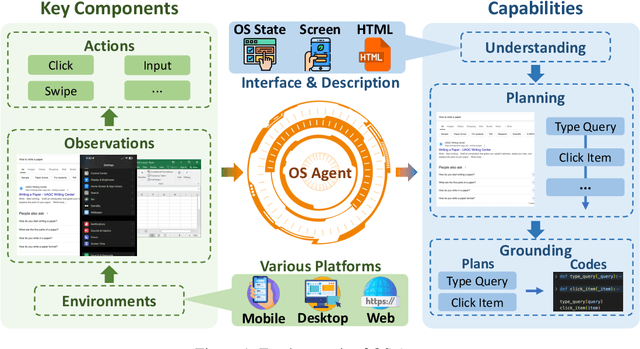
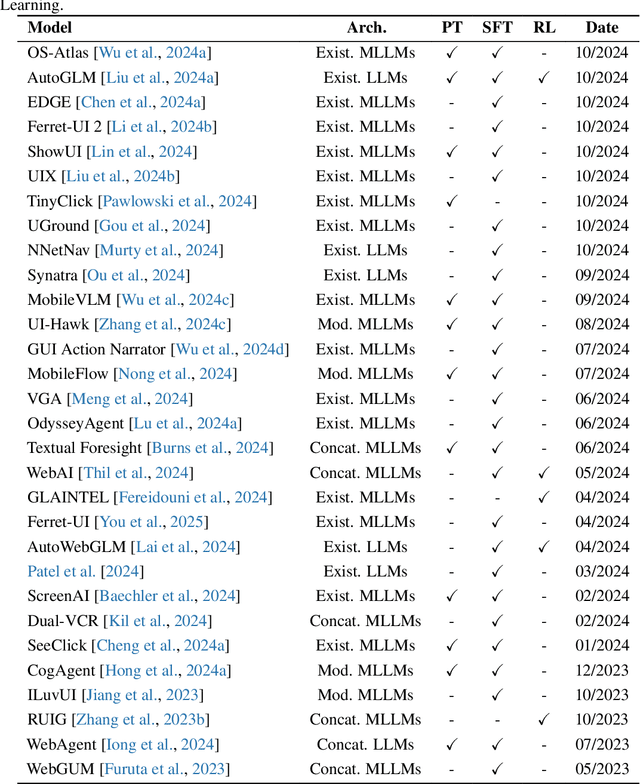
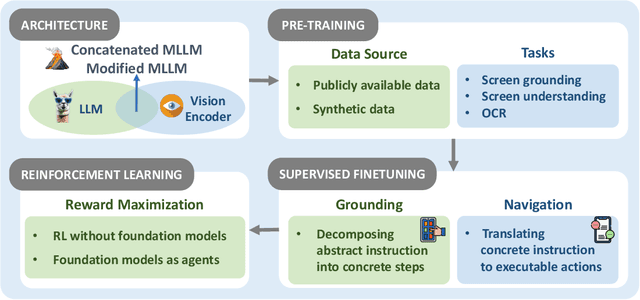
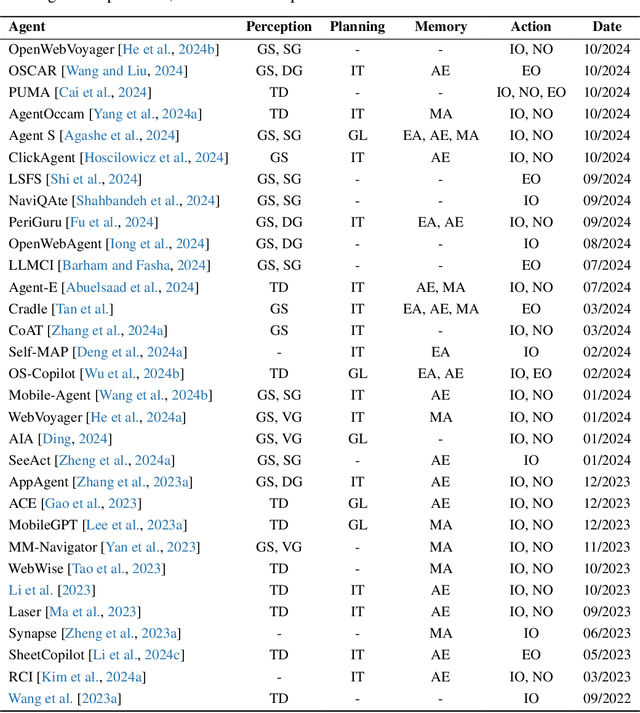
Abstract:The dream to create AI assistants as capable and versatile as the fictional J.A.R.V.I.S from Iron Man has long captivated imaginations. With the evolution of (multi-modal) large language models ((M)LLMs), this dream is closer to reality, as (M)LLM-based Agents using computing devices (e.g., computers and mobile phones) by operating within the environments and interfaces (e.g., Graphical User Interface (GUI)) provided by operating systems (OS) to automate tasks have significantly advanced. This paper presents a comprehensive survey of these advanced agents, designated as OS Agents. We begin by elucidating the fundamentals of OS Agents, exploring their key components including the environment, observation space, and action space, and outlining essential capabilities such as understanding, planning, and grounding. We then examine methodologies for constructing OS Agents, focusing on domain-specific foundation models and agent frameworks. A detailed review of evaluation protocols and benchmarks highlights how OS Agents are assessed across diverse tasks. Finally, we discuss current challenges and identify promising directions for future research, including safety and privacy, personalization and self-evolution. This survey aims to consolidate the state of OS Agents research, providing insights to guide both academic inquiry and industrial development. An open-source GitHub repository is maintained as a dynamic resource to foster further innovation in this field. We present a 9-page version of our work, accepted by ACL 2025, to provide a concise overview to the domain.
MiCoTA: Bridging the Learnability Gap with Intermediate CoT and Teacher Assistants
Jul 02, 2025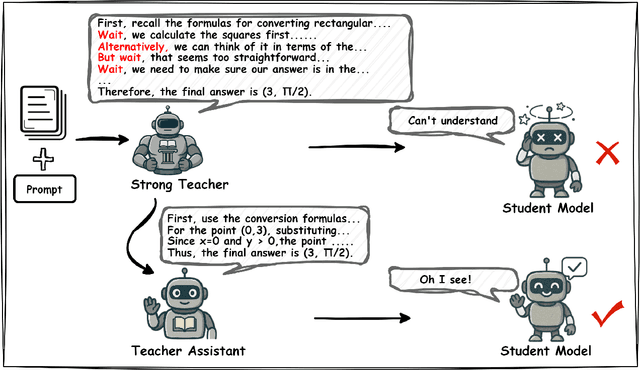

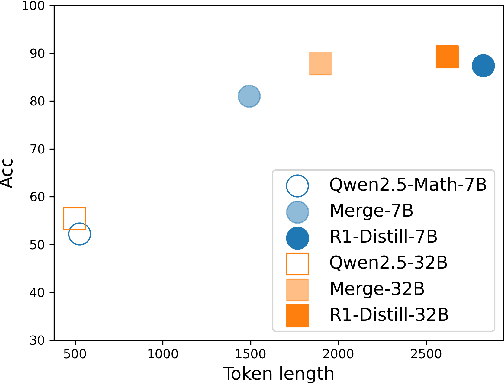
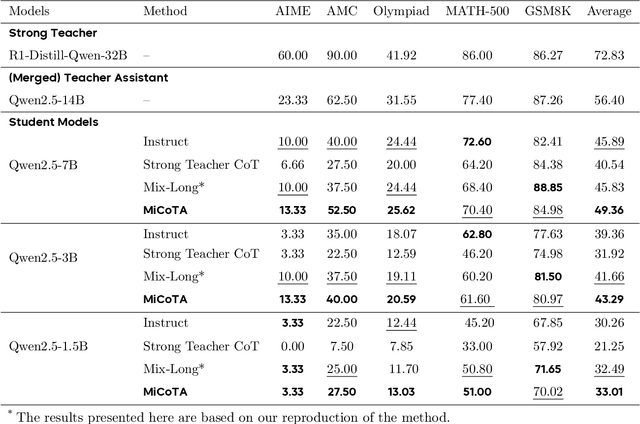
Abstract:Large language models (LLMs) excel at reasoning tasks requiring long thought sequences for planning, reflection, and refinement. However, their substantial model size and high computational demands are impractical for widespread deployment. Yet, small language models (SLMs) often struggle to learn long-form CoT reasoning due to their limited capacity, a phenomenon we refer to as the "SLMs Learnability Gap". To address this, we introduce \textbf{Mi}d-\textbf{Co}T \textbf{T}eacher \textbf{A}ssistant Distillation (MiCoTAl), a framework for improving long CoT distillation for SLMs. MiCoTA employs intermediate-sized models as teacher assistants and utilizes intermediate-length CoT sequences to bridge both the capacity and reasoning length gaps. Our experiments on downstream tasks demonstrate that although SLMs distilled from large teachers can perform poorly, by applying MiCoTA, they achieve significant improvements in reasoning performance. Specifically, Qwen2.5-7B-Instruct and Qwen2.5-3B-Instruct achieve an improvement of 3.47 and 3.93 respectively on average score on AIME2024, AMC, Olympiad, MATH-500 and GSM8K benchmarks. To better understand the mechanism behind MiCoTA, we perform a quantitative experiment demonstrating that our method produces data more closely aligned with base SLM distributions. Our insights pave the way for future research into long-CoT data distillation for SLMs.
Scaling Test-time Compute for LLM Agents
Jun 15, 2025Abstract:Scaling test time compute has shown remarkable success in improving the reasoning abilities of large language models (LLMs). In this work, we conduct the first systematic exploration of applying test-time scaling methods to language agents and investigate the extent to which it improves their effectiveness. Specifically, we explore different test-time scaling strategies, including: (1) parallel sampling algorithms; (2) sequential revision strategies; (3) verifiers and merging methods; (4)strategies for diversifying rollouts.We carefully analyze and ablate the impact of different design strategies on applying test-time scaling on language agents, and have follow findings: 1. Scaling test time compute could improve the performance of agents. 2. Knowing when to reflect is important for agents. 3. Among different verification and result merging approaches, the list-wise method performs best. 4. Increasing diversified rollouts exerts a positive effect on the agent's task performance.
PersonaFeedback: A Large-scale Human-annotated Benchmark For Personalization
Jun 15, 2025Abstract:With the rapid improvement in the general capabilities of LLMs, LLM personalization, i.e., how to build LLM systems that can generate personalized responses or services that are tailored to distinct user personas, has become an increasingly important research and engineering problem. However, unlike many new challenging benchmarks being released for evaluating the general/reasoning capabilities, the lack of high-quality benchmarks for evaluating LLM personalization greatly hinders progress in this field. To address this, we introduce PersonaFeedback, a new benchmark that directly evaluates LLMs' ability to provide personalized responses given pre-defined user personas and queries. Unlike existing benchmarks that require models to infer implicit user personas from historical interactions, PersonaFeedback decouples persona inference from personalization, focusing on evaluating the model's ability to generate responses tailored to explicit personas. PersonaFeedback consists of 8298 human-annotated test cases, which are categorized into easy, medium, and hard tiers based on the contextual complexity of the user personas and the difficulty in distinguishing subtle differences between two personalized responses. We conduct comprehensive evaluations across a wide range of models. The empirical results reveal that even state-of-the-art LLMs that can solve complex real-world reasoning tasks could fall short on the hard tier of PersonaFeedback where even human evaluators may find the distinctions challenging. Furthermore, we conduct an in-depth analysis of failure modes across various types of systems, demonstrating that the current retrieval-augmented framework should not be seen as a de facto solution for personalization tasks. All benchmark data, annotation protocols, and the evaluation pipeline will be publicly available to facilitate future research on LLM personalization.
TaskCraft: Automated Generation of Agentic Tasks
Jun 11, 2025Abstract:Agentic tasks, which require multi-step problem solving with autonomy, tool use, and adaptive reasoning, are becoming increasingly central to the advancement of NLP and AI. However, existing instruction data lacks tool interaction, and current agentic benchmarks rely on costly human annotation, limiting their scalability. We introduce \textsc{TaskCraft}, an automated workflow for generating difficulty-scalable, multi-tool, and verifiable agentic tasks with execution trajectories. TaskCraft expands atomic tasks using depth-based and width-based extensions to create structurally and hierarchically complex challenges. Empirical results show that these tasks improve prompt optimization in the generation workflow and enhance supervised fine-tuning of agentic foundation models. We present a large-scale synthetic dataset of approximately 36,000 tasks with varying difficulty to support future research on agent tuning and evaluation.
AI PERSONA: Towards Life-long Personalization of LLMs
Dec 17, 2024Abstract:In this work, we introduce the task of life-long personalization of large language models. While recent mainstream efforts in the LLM community mainly focus on scaling data and compute for improved capabilities of LLMs, we argue that it is also very important to enable LLM systems, or language agents, to continuously adapt to the diverse and ever-changing profiles of every distinct user and provide up-to-date personalized assistance. We provide a clear task formulation and introduce a simple, general, effective, and scalable framework for life-long personalization of LLM systems and language agents. To facilitate future research on LLM personalization, we also introduce methods to synthesize realistic benchmarks and robust evaluation metrics. We will release all codes and data for building and benchmarking life-long personalized LLM systems.
Symbolic Learning Enables Self-Evolving Agents
Jun 26, 2024



Abstract:The AI community has been exploring a pathway to artificial general intelligence (AGI) by developing "language agents", which are complex large language models (LLMs) pipelines involving both prompting techniques and tool usage methods. While language agents have demonstrated impressive capabilities for many real-world tasks, a fundamental limitation of current language agents research is that they are model-centric, or engineering-centric. That's to say, the progress on prompts, tools, and pipelines of language agents requires substantial manual engineering efforts from human experts rather than automatically learning from data. We believe the transition from model-centric, or engineering-centric, to data-centric, i.e., the ability of language agents to autonomously learn and evolve in environments, is the key for them to possibly achieve AGI. In this work, we introduce agent symbolic learning, a systematic framework that enables language agents to optimize themselves on their own in a data-centric way using symbolic optimizers. Specifically, we consider agents as symbolic networks where learnable weights are defined by prompts, tools, and the way they are stacked together. Agent symbolic learning is designed to optimize the symbolic network within language agents by mimicking two fundamental algorithms in connectionist learning: back-propagation and gradient descent. Instead of dealing with numeric weights, agent symbolic learning works with natural language simulacrums of weights, loss, and gradients. We conduct proof-of-concept experiments on both standard benchmarks and complex real-world tasks and show that agent symbolic learning enables language agents to update themselves after being created and deployed in the wild, resulting in "self-evolving agents".
Weaver: Foundation Models for Creative Writing
Jan 30, 2024



Abstract:This work introduces Weaver, our first family of large language models (LLMs) dedicated to content creation. Weaver is pre-trained on a carefully selected corpus that focuses on improving the writing capabilities of large language models. We then fine-tune Weaver for creative and professional writing purposes and align it to the preference of professional writers using a suit of novel methods for instruction data synthesis and LLM alignment, making it able to produce more human-like texts and follow more diverse instructions for content creation. The Weaver family consists of models of Weaver Mini (1.8B), Weaver Base (6B), Weaver Pro (14B), and Weaver Ultra (34B) sizes, suitable for different applications and can be dynamically dispatched by a routing agent according to query complexity to balance response quality and computation cost. Evaluation on a carefully curated benchmark for assessing the writing capabilities of LLMs shows Weaver models of all sizes outperform generalist LLMs several times larger than them. Notably, our most-capable Weaver Ultra model surpasses GPT-4, a state-of-the-art generalist LLM, on various writing scenarios, demonstrating the advantage of training specialized LLMs for writing purposes. Moreover, Weaver natively supports retrieval-augmented generation (RAG) and function calling (tool usage). We present various use cases of these abilities for improving AI-assisted writing systems, including integration of external knowledge bases, tools, or APIs, and providing personalized writing assistance. Furthermore, we discuss and summarize a guideline and best practices for pre-training and fine-tuning domain-specific LLMs.
 Add to Chrome
Add to Chrome Add to Firefox
Add to Firefox Add to Edge
Add to Edge